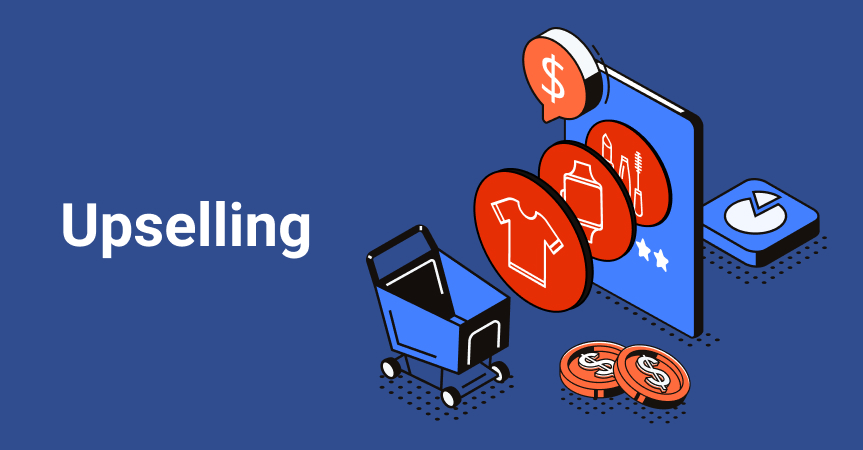In today’s competitive business landscape, maximizing revenue from existing customers is crucial for success. While customer acquisition remains important, upselling and cross-selling techniques can significantly boost your bottom line without the need for constant lead generation. But what exactly are upselling and cross-selling, and how can you leverage them effectively? This guide will equip you with the knowledge and strategies to become a master of these sales techniques.
 Cross-selling is ideal for:
Cross-selling is ideal for:
Understanding Upselling and Cross-Selling
Upselling and cross-selling, while often used interchangeably, are distinct strategies:- Upselling: Incentivizing customers to opt for a more premium version of the product they are considering. Imagine a customer browsing laptops. Upselling might involve suggesting a model with more RAM or a faster processor, highlighting the performance benefits for the customer’s specific needs.
- Cross-Selling: Recommending complementary products that enhance the value of the original purchase. Continuing with the laptop example, cross-selling might involve suggesting a carrying case, wireless mouse, or extended warranty to complement the laptop purchase.
Upselling Strategies That Convert
Effective upselling hinges on understanding customer needs and identifying upsell opportunities during the sales process:- Targeted Upselling: Don’t push upgrades on every customer. Analyze their needs and suggest upgrades that address specific pain points or enhance their experience. For instance, a customer looking for a basic laptop for web browsing might not need a top-of-the-line model with a powerful graphics card. However, if they mention using photo editing software, recommending a model with a better graphics card positions the upgrade as a solution to their specific need.
- Value Proposition: Focus on the “why” behind the upsell. Explain the additional benefits and features associated with the upgraded product and how it ultimately provides more value for the customer. In the laptop example, highlight how the upgraded processor translates to faster loading times and smoother performance for photo editing software.
- Bundled Packages: Create attractive bundled packages that combine the original product with complementary items at a discounted price. This incentivizes customers to upgrade while offering them a cost-saving advantage. For example, bundle a laptop with a carrying case, wireless mouse, and antivirus software at a discounted price compared to purchasing them individually.
- Limited-Time Offers: Leverage the power of scarcity by offering limited-time discounts or promotions on upgrades. Create a sense of urgency and encourage customers to take advantage of the upsell opportunity before it disappears. This could involve offering a free upgrade to a higher storage capacity laptop if the customer purchases within the next 24 hours.
Mastering the Art of Cross-Selling
Successful cross-selling relies on strategic product recommendations:- Relevant Recommendations: Avoid overwhelming customers with irrelevant suggestions. Focus on recommending complementary products that enhance the functionality or value of the original purchase. Don’t suggest a printer to a customer buying a tablet unless they express a need for printing capabilities.
- Personalized Approach: Utilize website recommendation tools to suggest relevant products based on a customer’s browsing behavior or purchase history. Personalization creates a more targeted and effective approach. For instance, if a customer views a specific pair of running shoes, recommend complementary items like running socks, moisture-wicking apparel, or a fitness tracker based on their browsing behavior.
- Strategic Placement: Don’t underestimate the power of physical placement. Strategically position complementary products near the point of sale or on product pages to grab customer attention and encourage impulse purchases. Utilize clear messaging to highlight how these products add value to the original purchase. For example, place a display of phone cases and screen protectors next to smartphones on your website or in your store.
Implementing Upselling and Cross-Selling Strategies
For successful implementation, consider these factors:- Sales Team Training: Equip your sales team with the knowledge and techniques to effectively recommend upgrades and complementary products. Invest in training programs that focus on identifying upsell opportunities and delivering compelling value propositions. Train your team to be consultative and focus on understanding customer needs before suggesting upgrades or add-ons.
- Customer Data Leverage: Utilize customer data to personalize your upselling and cross-selling efforts. Analyze purchase history and browsing behavior to recommend products that are relevant to individual customer needs. This can be done through website analytics tools or a CRM system that tracks customer interactions.
- A/B Testing and Optimization: Continuously test and refine your upselling and cross-selling strategies through A/B testing. Analyze results to see what resonates with your audience and optimize your approach for maximum effectiveness. Test different upsell offers, cross-selling placements, and messaging to see what generates the best results.
The Ethical Approach to Upselling and Cross-Selling
Upselling and cross-selling should be customer-centric strategies, focused on maximizing customer value and satisfaction, not just profit margins. Here’s how to ensure your approach is ethical and builds trust:- Prioritize Customer Value: Focus on recommending upgrades and add-ons that genuinely solve customer problems or enhance their experience. Avoid aggressive upselling tactics that pressure customers into unnecessary purchases. Remember, happy customers are more likely to become repeat customers and recommend your business to others.
- Transparency is Key: Be upfront and transparent about product features and pricing during the upselling and cross-selling process. Don’t mislead customers or make false claims about the benefits of upgrades or add-ons. Provide clear information so customers can make informed decisions based on their needs and budget.
SEO Optimization for Maximum Visibility
- Keyword Research: Identify relevant keywords related to upselling and cross-selling, including long-tail keywords with lower competition but higher search intent. For example, “upselling techniques for ecommerce” or “best practices for cross-selling in retail.” Incorporate these keywords naturally throughout your content to improve search engine ranking.
- Title Tag and Meta Description: Craft a compelling title tag and meta description that accurately reflects your content and includes your target keyphrase (“upselling and cross-selling”). Optimize these snippets to entice users to click on your content in search engine results. For example, title tag: “Upselling vs. Cross-Selling: The Ultimate Guide to Boosting Sales” and meta description: “Learn how to master upselling and cross-selling techniques to increase revenue and customer satisfaction.”
- Content Structure and Internal Linking: Structure your content logically with clear headings and subheadings to improve readability and user experience. Use internal linking to connect your blog post to other relevant content on your website, such as product pages or articles about customer service. This improves website navigation and SEO value.
Which Is Better: Upselling Or Cross-Selling?
There’s no single “better” option between upselling and cross-selling – it really depends on the situation and your goals. Here’s a breakdown to help you decide: Upselling is ideal for:- Increasing the value of each sale: If your profit margins allow for offering higher-end versions of your product, upselling can significantly boost your revenue.
- Targeting customers who might benefit from more features: Upselling allows you to tailor your offer to a customer’s specific needs.
- Creating a sense of exclusivity: Offering premium products can enhance brand perception and attract customers seeking high-quality options.
 Cross-selling is ideal for:
Cross-selling is ideal for:
- Boosting average order value (AOV): By recommending complementary products, you encourage customers to spend more overall.
- Enhancing customer experience: Cross-selling can provide customers with everything they need for a complete solution, improving their overall satisfaction.
- Moving slow-moving inventory: Cross-selling allows you to bundle less popular products with high-demand items, promoting sales of both.







